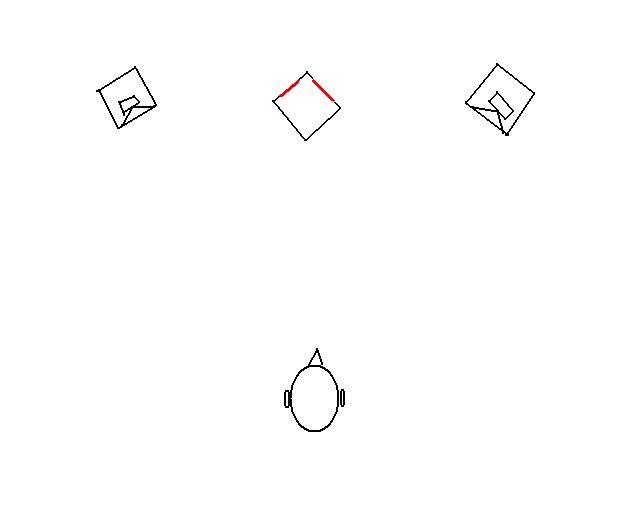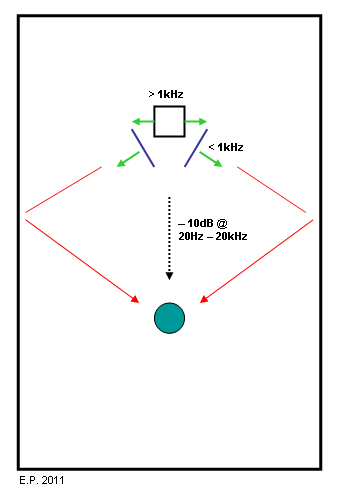sure!
so,the box is pvc tube and cap (10cm diam,15 cm length),drivers are tc9 vifa and ox vifa,common load volume for tc9(i will try separate volume) damping between drivers,this setting allowed me to vary the drivers distance from 15 to 21 cm,no noticeable difference,by ears and measurement (with 1 mic)
filtering is ,hp 24db/oct 200hz (tc9),nothing esle,the tweeter hp was define to match with the 90° response of the tc9,first hp 24/2700 second 12/3300 and before filtering M/S "processor" and delay on mid channel finaly,a sub just to have the low extension,but not ok with this setup.
the room where i "experiment" is a bedroom and a badroom , 10m2 very dead sound,that's why i think m/s has good potential ,i can hear a wide soundstage that goes out of the room ,...but not always a accurate stereo placement,sometime i "loose" the stereo, musicians are centered ,i need to close my eyes to recover placement,strange sensation..in other cases, it has a very realistic soundstage if the soudstage is well recorded
it's a attractive experience
so,the box is pvc tube and cap (10cm diam,15 cm length),drivers are tc9 vifa and ox vifa,common load volume for tc9(i will try separate volume) damping between drivers,this setting allowed me to vary the drivers distance from 15 to 21 cm,no noticeable difference,by ears and measurement (with 1 mic)
filtering is ,hp 24db/oct 200hz (tc9),nothing esle,the tweeter hp was define to match with the 90° response of the tc9,first hp 24/2700 second 12/3300 and before filtering M/S "processor" and delay on mid channel finaly,a sub just to have the low extension,but not ok with this setup.
the room where i "experiment" is a bedroom and a badroom , 10m2 very dead sound,that's why i think m/s has good potential ,i can hear a wide soundstage that goes out of the room ,...but not always a accurate stereo placement,sometime i "loose" the stereo, musicians are centered ,i need to close my eyes to recover placement,strange sensation..in other cases, it has a very realistic soundstage if the soudstage is well recorded
it's a attractive experience
Member
Joined 2009
Paid Member
Interesting thread, I saw the Stereolith website a year so ago and like the idea but never tried to DIY anything. I'm wondering if as a result of the experimentation that's been done, is there a suggested DIY project for people to try out ?
I was wondering about desktop speakers, placing speakers behind computer monitor but firing sideways/slightly to the rear rather than in-your-face firing front from each side of the monitor ????
I was wondering about desktop speakers, placing speakers behind computer monitor but firing sideways/slightly to the rear rather than in-your-face firing front from each side of the monitor ????
Hello,
IF sereolith would be MS, it would change quite a lot of things, but the question remains if it is?
On the other hand Markus' measurements showed no midrange driver beaming at 10kHz, so are the drivers internally connected somehow.. an MS filter?
- Elias
IF sereolith would be MS, it would change quite a lot of things, but the question remains if it is?
On the other hand Markus' measurements showed no midrange driver beaming at 10kHz, so are the drivers internally connected somehow.. an MS filter?
- Elias
...
now i have to investigate on signal proccessing in M/S condition, but it seems to me, that "stereolith" have a passive M/S treatment ,and use the dual voice coil of the drivers to acheive this.
that said ,m/S is a way to go in stereo reproduction
...
i think m/s has good potential ,i can hear a wide soundstage that goes out of the room ,...but not always a accurate stereo placement,sometime i "loose" the stereo, musicians are centered ,i need to close my eyes to recover placement,strange sensation..in other cases, it has a very realistic soundstage if the soudstage is well recorded
it's a attractive experience
Member
Joined 2003
How about cardioid midbass to replace the cardboard/pillow "blockers"? That, and a couple of coaxial or WG tweeters might move along the path this seems headed. A pair of KEF ceiling speakers in a cardioid box?
I haven't measured the pillow
Actually I had measured it already, I just didn't know it 😀
Here the cardboard proto measured at the listening position at 2m in my living room. The direct sound is at 0.007s.
An externally hosted image should be here but it was not working when we last tested it.
Here with the pillow:
An externally hosted image should be here but it was not working when we last tested it.
The pillow attenuates direct sound by 5-15dB above 700Hz in a low pass manner.
Important is: This level of the attenuation in this frequency range, with the given level of side wall reflections, is completely enough to avoid the localisation of the box in any conditions more than about 1.5m distance.
- Elias
Last edited:
On the other hand Markus' measurements showed no midrange driver beaming at 10kHz, so are the drivers internally connected somehow.. an MS filter?
- Elias
The midwoofers aren't connected internally.
I did take a look at the graphs again and have to admit that the graphs are wrong. I did gate the impulse response of minimum phase copies instead of gating the original impulse responses. Sorry for that. Here's the correct data (0°-90°, 1m mic distance, frequency resolution 125Hz):
An externally hosted image should be here but it was not working when we last tested it.
Re: The Mid-Side issue that has re-surfaced a few times: IIRC, markus verified for us previously that the midwoofs are in-phase . . . So that pretty much rules-out the M-S configuration. There would also be zero bass if operating small drivers as a dipole (bass is captured in M-S recording by the mono Mid mic; but in playback on stereolith, the bass must be reproduced by the sides)
I suppose it's possible that they could be shifted out of phase just in the midrange . . . but Markus's measurements would reveal if this were the case.
I suppose it's possible that they could be shifted out of phase just in the midrange . . . but Markus's measurements would reveal if this were the case.
The midwoofers aren't connected internally.
I did take a look at the graphs again and have to admit that the graphs are wrong. I did gate the impulse response of minimum phase copies instead of gating the original impulse responses. Sorry for that. Here's the correct data (0°-90°, 1m mic distance, frequency resolution 125Hz):
An externally hosted image should be here but it was not working when we last tested it.
please take o look at the rest of Your posts in this thread, perhaps there is more misinformation/misinterpetation posted to be sorry for
Arcam's highly successful stereolit: the rCube
http://www.arcam.co.uk/_ugc/file/rCube-v2-Mar11.pdf
http://www.arcam.co.uk/_ugc/file/rCube_Mane.pdf
http://www.arcam.co.uk/_ugc/file/rCube-v2-Mar11.pdf
http://www.arcam.co.uk/_ugc/file/rCube_Mane.pdf
Attachments
some ideas of three channel setup inspired by Stereolith and Elias' research:
from el`Ol:

and below my own humble proposition:
from el`Ol:
What about such a setup, where you would try to avoid the problem with treble localization and work conventional in the less critical region?

and below my own humble proposition:
Attachments
Upgrading the stereolithic projection. Removal of the pillow direct sound blocker. Low freqs are handled by crossed dipoles ! This way it is possuble to set the required level of direct sound attenuation by toeing the dipoles. The attenuation is possible through the whole audio band. High freqs handled by side firing box system.

- Elias

- Elias
Attachments
Upgrading the stereolithic projection. Removal of the pillow direct sound blocker. Low freqs are handled by crossed dipoles ! This way it is possuble to set the required level of direct sound attenuation by toeing the dipoles. The attenuation is possible through the whole audio band. High freqs handled by side firing box system.
...
- Elias
 I have to think
I have to thinkps.
I like the "E.P. 2011" signature 😀
Upgrading the stereolithic projection. Removal of the pillow direct sound blocker. Low freqs are handled by crossed dipoles ! This way it is possuble to set the required level of direct sound attenuation by toeing the dipoles. The attenuation is possible through the whole audio band. High freqs handled by side firing box system.
It should work, but would only work for one listener in a fixed position - Dipole nulls are pretty narrow. This might be okay for some individuals.
Dipole configuration would be critical as well: treble creeps into the null on many dipoles because baffle width exceeds high freq wavelength -- can't form a null at high frequencies. A ribbon on a very narrow baffle could pull it off.
. . . perhaps the treble can be controlled with a waveguide, or a pillow on the baffle edge, or use a beamy fullrange driver . . . hmm. . . 😱
Last edited:
It should work, but would only work for one listener in a fixed position
Well, this IS a stereo system !!! 😀
Even though discussion in a stereo loudspeaker thread was not encouraged 🙁
- Dipole nulls are pretty narrow.
Listener is not in the dipole null, but off axis ! Only requirement is attenuate the direct sound at least 10dB. 10dB is approximation, it could be less than that is enough. Markus was explaining about 5dB, so...
Dipole configuration would be critical as well: treble creeps into the null on many dipoles because baffle width exceeds high freq wavelength -- can't form a null at high frequencies.
Dipole is for low freqs only ! Easy 🙂
- Elias
Could work. What drivers are you using?
It will ! 🙂 This is at the concept stage ! No drivers selected yet.
Thinking again:
This could also work as a base for stereolith below 1kHz

Directivity gained by an array.
Plus, if made in a box no back wave.
The crossed dipoles do have back wave, but because it has some delay, and it's negative phase, it could turn out enhancing spaciousness 😀
- Elias
This could also work as a base for stereolith below 1kHz

Directivity gained by an array.
Plus, if made in a box no back wave.
The crossed dipoles do have back wave, but because it has some delay, and it's negative phase, it could turn out enhancing spaciousness 😀
- Elias
How about cardioid midbass to replace the cardboard/pillow "blockers"?
Hmm.. Theoretical 1st order cardioid have only 6 dB side attenuation at 90 degrees off axis. Maybe not anough ? Sure, practical cardioid could have more side attenuation, yes 😀
How about second order cardioid ? The most rare loudspeaker concept ever !
WG tweeters
Do these have to be constant directivity ?

- Elias
It will ! 🙂 This is at the concept stage ! No drivers selected yet.
You could get these Fostexes
Paar(2Stück)ACR Fostex Magnetostaten FS21 RP | eBay
Fostex FS21RP
for proof of concept and then switch to the Expolinear (that measures far better).
Last edited:
- Home
- Loudspeakers
- Multi-Way
- Stereolith Loudspeakers Question


